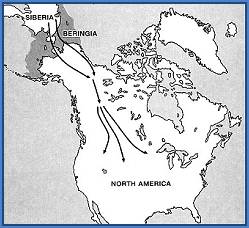|
 |
This is the time we try the ancient skill our fathers taught
for ivory or bone:
The patiently whirling of the teeth-held
drill, the careful cut with copper knife or stone,
The tribal pattern and the graceful line --
yet simple forms are all we ever choose
But always there must be a pure design of beauty in the
native things we use.
j.c.f. |
 |
There are 229 federally recognized
Alaskan villages and five unrecognized Tlingit Alaskan Indian tribes.
About 20 percent of Alaska’s
650,000 residents are Native or have Native descent
(numbering 119,241 as of the 2000 Federal census). In over 200 rural
villages and communities
Alaskan Natives make up
a significant segment of the population. Many Alaskan Natives have
retained their customs, language, hunting and fishing practices and ways
of living since "the creation times."
 The
earliest human beings to inhabit North America are known as Paleo-Indians.
Although it is not known precisely when they first arrived at North
America, archaeologists believe they crossed the Bering Strait about
12,000 years ago and migrated from Siberia to Alaska. These people were the ancestors of the
Eskimo and Aleuts, whose material culture was founded in the
Siberian-American Paleoarctic tradition. The
earliest human beings to inhabit North America are known as Paleo-Indians.
Although it is not known precisely when they first arrived at North
America, archaeologists believe they crossed the Bering Strait about
12,000 years ago and migrated from Siberia to Alaska. These people were the ancestors of the
Eskimo and Aleuts, whose material culture was founded in the
Siberian-American Paleoarctic tradition.
Artifacts have shown that another migration of Ancients took
place, but they sailed through the Bering Strait on hide-covered watercraft
instead of crossing the bridge. This migration possibly
included the ancestors of interior Alaskan Indians and the Pacific Northwest
coast Indians. These people were nomadic gatherers and caribou hunters whose abandoned camps are scattered across
eastern Siberia and interior Alaska.
Using tools created from stone, bone,
sinew, wood, fiber, and moss, they invented secure dwellings and tailored skin
clothing. They developed expert control of fire, including the use of
alternative fuels such as animal dung, finely broken bone, and fat or oil in
areas lacking woody plants. They learned to travel over snow and ice. They also
learned to cope with long hours of winter darkness. These ancient people were skilled in many of the arts and sciences we pursue
today. They possessed profound biological knowledge - the nutritional and
medicinal properties of many plants and the habits and anatomy of many animals.
They were experts at finding geological deposits that contained stone suitable
for flaking into tools and grinding into pigments. They were storytellers who
entertained and educated themselves by passing on oral histories and knowledge
from one generation to another.
|
